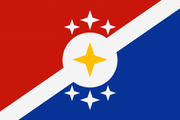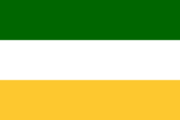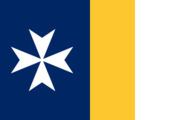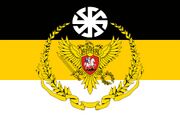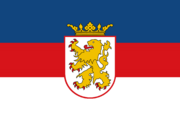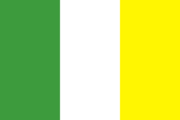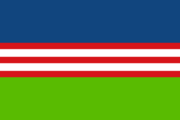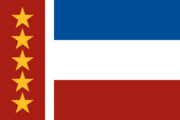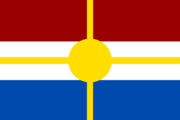Kento-Polyash languages: Difference between revisions
mNo edit summary |
m ({{Region icon Anteria}}) |
||
| (44 intermediate revisions by 3 users not shown) | |||
| Line 1: | Line 1: | ||
{{Infobox language family | {{Region icon Anteria}}{{Infobox language family | ||
| name = Kento-Polyash | | name = Kento-Polyash<!-- language--> | ||
| altname = Thuad Slavic | | altname = Thuad Slavic<!-- language--> | ||
| ethnicity = Thuadian Slavs | | ethnicity = Thuadian Slavs | ||
| image = Flag_of_Yugoslavia_(1918–1941).svg | |||
| imagesize = <!-- or image_size --> | |||
| imagealt = | |||
| imagecaption = [[wikipedia:Pan-Slavic colors|Pan-Slavic flag]] | |||
| region = Southern [[Thuadia]]<br>''So called "Slavic Belt"'' | | region = Southern [[Thuadia]]<br>''So called "Slavic Belt"'' | ||
| familycolor = | | speakers = ~ 500 million | ||
| fam1 = [ | | familycolor = Indo-European | ||
| fam1 = [[Thuado-Thrismaran languages|Thuado-Thrismaran]] | |||
| fam2 = [https://en.wikipedia.org/wiki/Balto-Slavic_languages Zarav-Slavic] | | fam2 = [https://en.wikipedia.org/wiki/Balto-Slavic_languages Zarav-Slavic] | ||
| fam3 = [https://en.wikipedia.org/wiki/Slavic_languages Slavic] | | fam3 = [https://en.wikipedia.org/wiki/Slavic_languages Slavic] | ||
| Line 13: | Line 18: | ||
| [[Monte Blanco]] | | [[Monte Blanco]] | ||
| [[Gadorien]] | | [[Gadorien]] | ||
| [[Qazhshava]] | |||
| [[Prei Meas]] | | [[Prei Meas]] | ||
| [[Bakyern]] | | [[Bakyern]] | ||
| Line 20: | Line 26: | ||
| [[Kentalis]] | | [[Kentalis]] | ||
| [[Khemmi]] | | [[Khemmi]] | ||
| [[Krenya]] | |||
}}<br>{{Collapsible list | |||
| title = • Tiskai-Qash | |||
| [[Kistolia]] | |||
| [[Tiskaiya]] | | [[Tiskaiya]] | ||
| [[ | | [[Qazhshava]] | ||
}}<br>{{Collapsible list | }}<br>{{Collapsible list | ||
| title = • Veltorian | | title = • Veltorian | ||
| Line 28: | Line 38: | ||
| [[Bretislavia]] | | [[Bretislavia]] | ||
}} | }} | ||
| child1 = | <!--| child1 = [https://en.wikipedia.org/wiki/Czech_language Velnotian] | ||
| child2 = | | child2 = [https://en.wikipedia.org/wiki/Slovene_language Torvonesse] | ||
| child3 = | | child3 = [https://en.wikipedia.org/wiki/Serbian_language Kental] | ||
| child4 = | | child4 = [https://en.wikipedia.org/wiki/Rusyn_language Ereskaneese] | ||
| child5 = Protisean | |||
| child6 = Amarnan | |||
| child7 = Bralea | |||
| child8 = [[Bisveni language|Bisveni]] | |||
| child9 = [https://en.wikipedia.org/wiki/Surzhyk Tiskai] | |||
| child10 = [[wikipedia:Kashubian language|Pecian]] | |||
| child11 = [[Kodin language|Kodin]] | |||
| child12 = [[Louzen language|Louzen]] | |||
| child13 = [[Zhoushi language|Zhoushi]] | |||
| child14 = [https://en.wikipedia.org/wiki/Slovak_language Slovanic] | |||
| child15 = [https://en.wikipedia.org/wiki/Sorbian_languages Ulevan] | |||
| child16 = [[wikipedia:Interslavic language|Srednogorian]] | |||
| child17 = {{wp|Bulgarian language|Varnolan}} | |||
| child18 = [[wikipedia:Poglish|Poglish]] | |||
| child19 = [[wikipedia:Polish language|Scouse]] | |||
| child20 = [[Vealphk language|Vealphk]] | |||
| child21 = [[Storvani language|Storvani]] | |||
| child22 = [[Belgorian language|Belgorian]] | |||
| child23 = [[Karaalani language|Karaalanish]] | |||
| child24 = [[Gorgavian language|Gorgavian]] | |||
| child25 = Arasatian | |||
| child26 = | |||
| child27 = | |||
| child28 = | |||
| child29 = | |||
| child30 = --> | |||
| map = ThuadSlavs2020.png | | map = ThuadSlavs2020.png | ||
| mapalt = Location of languages | | mapalt = Location of languages | ||
| mapcaption = {{Collapsible list | | mapcaption = {{Collapsible list | ||
| title = Distribution of the languages | | title = Distribution of the languages | ||
|{{ | |{{legend|#C04F2E|[https://en.wikipedia.org/wiki/Czech_language Utochise]}} | ||
|{{ | |{{legend|#9E0B0F|[https://en.wikipedia.org/wiki/Slovene_language Torvonesse]}} | ||
|{{ | |{{legend|#8560A9|[https://en.wikipedia.org/wiki/Serbian_language Kental]}} | ||
|{{ | |{{legend|#003FCD|[https://en.wikipedia.org/wiki/Rusyn_language Ereskaneese]}} | ||
|{{ | |{{legend|#A864A9|[[Protisean language|Protisean]]}} | ||
|{{ | |{{legend|#1B1464|[[Amarnan language|Amarnan]]}} | ||
|{{ | |{{legend|#998675|[[Bralean language|Bralean]]}} | ||
|{{ | |{{legend|#ABA000|[[Bisveni language|Bisveni]]}} | ||
|{{ | <!--|{{legend|#666666|[[wikipedia:Bosnian language|Alzalic]]}}--> | ||
|{{ | |{{legend|#197B30|[https://en.wikipedia.org/wiki/Surzhyk Tiskai]}} | ||
|{{ | |{{legend|#75A831|[[wikipedia:Kashubian language|Pecian]]}} | ||
|{{ | |{{legend|#0072BC|[[Kodin language|Kodin]] (Tiskai-Louzi)}} | ||
|{{ | |{{legend|#B2FF00|<!--[https://en.wikipedia.org/wiki/German-Russian_macaronic_language Louzenish][[Gadorien|Louzenish]]--> [[Louzen language|Louzen]]}} | ||
|{{ | |{{legend|#5DB0FF|[[Zhoushi language|Zhoushi]] ([https://iiwiki.us/wiki/Zhousheng#Bogmian_perspective Bogmian])}} | ||
|{{ | |{{legend|#EE1C24|[https://en.wikipedia.org/wiki/Slovak_language Slovanic]}} | ||
|{{legend|#F6989D|[https://en.wikipedia.org/wiki/Sorbian_languages Ulevan]}} | |||
|{{legend|#790000|[[wikipedia:Interslavic language|Srednogorian]]}} | |||
|{{legend|#F357C2|{{wp|Bulgarian language|Varnolan}}}} | |||
|{{legend|#FDC689|[[wikipedia:Poglish|Poglish]]}} | |||
|{{legend|#F8941D|[[wikipedia:Polish language|Scouse]]}} | |||
|{{legend|#92278F|[[Vealphk language|Vealphk]]}} | |||
|{{legend|#F36C4F|[[Storvani language|Storvani]]}} | |||
|{{legend|#61FFBD|[[Belgorian language|Belgorian]]}} | |||
|{{legend|#ED008C|[[Karaalani language|Karaalanish]]}} | |||
|{{legend|#F26522|[[Gorgavian language|Gorgavian]]}} | |||
|{{legend|#FFF200|[[Arasatian language|Arasatian]]}} | |||
|[[File:Icon-gears.png|21px|link=https://en.wikipedia.org/wiki/Zonal_constructed_language]] [[wikipedia:Slovio|Neo-Mustelarian]]}} | |||
| mapsize = 350 | | mapsize = 350 | ||
}} | }} | ||
Kento-Polyash languages are a Slavic language subgroup present in southern [[Thuadia]], mostly in the areas of the [[Sekidean Union]].<br> | Kento-Polyash languages are a Slavic language subgroup present in southern [[Thuadia]], mostly in the areas of the [[Sekidean Union]]. | ||
[[File:Flag_of_Yugoslavia_(1918–1941).svg|thumb|Unofficial [https://en.wikipedia.org/wiki/Pan-Slavic_colors Pan-Slavic flag] used since 1850's]]<br> | |||
[[File:Pan-qazhshavan-slavic flag.png|thumb|Official flag of the slavic people of Qazhshava used since 1998. It was modeled after the official flag of [https://iiwiki.us/wiki/Qazhshava Qazhshava] and the unofficial [https://en.wikipedia.org/wiki/Pan-Slavic_colors Pan-Slavic flag].]] | |||
===History=== | ===History=== | ||
Kento-Polyash languages diverged from Germanic languages in the area of present-day southern [[Nerany]] in about | Kento-Polyash languages diverged from Germanic languages in the area of present-day southern [[Nerany]] in about 1st century BCE and slowly migrated to the equator in a span of 400 years, populating area from western [[Torvon]] across [[Kentalis]], [[Krenya]], [[Khemmi]], [[Gadorien]], [[Zhousheng]], southern [[Bakyern]], [[Monte Blanco]] and western [[Gabrielland]]. In about 6th century AD, Germanic tribes, mainly southern Bak tribes and Gadorieni tribes started pushing on Slavic settlements. Over time, most of the Slavic population, called the "Kartovians" in [[Gadorien]] was assimiliated into [[Gadorien|Gadori]] culture and language, only keeping old traditions in the remote area of [[Gadorien|Louzeni]]. Similar thing happened in Southern [[Bakyern]], although there is still a area with a [https://en.wikipedia.org/wiki/Sorbian_languages Ulevan] majority. In the end of the first millenium, most of the areas formerly settled by Slavs in [[Torvon]] and in [[Gadorien]] has been assimilated into their new cultures (In the remote Duchy of Louzeni in Gadorien, [[Gadorien|Louzenish]] was created as a slavic language with strong germanic influences). Similar thing happened in [[Ereska]], when new [[Khemmi|Khemmic]] settlers formed a lingustic corridor, splitting Kentalis from Ereska. Currently, Kento-Polyash languages are a majority in [[Mustelaria]] and [[Kentalis]] and a plurality in [[Krenya]], while retaining minority status in [[Gabrielland]] and [[Gadorien]]. | ||
===Writing and alphabets=== | ===Writing and alphabets=== | ||
Former writing style of all Kento-Polyash languages was [https://en.wikipedia.org/wiki/Coptic_alphabet Protopolyash miniscule], which was retained until 18. century in most of the linguistic areas, but was eventually abandoned or edited in most of the countries (it is currently still used by [[Monte Blanco|Belgorian]], [[Monte Blanco|Gorgavian]] and [[Karaalani Language|Karaalanish]]). Main problems with the script are lack of phonemes used in many languages, which makes one character represent multiple sounds and problems of drawing the letter, as some of them are complicated to be easily recognized from each other. [[Kentalis]] has reformed the script into a [https://en.wikipedia.org/wiki/Serbian_Cyrillic_alphabet Kentalan alphabet], while [https://iiwiki.us/wiki/Zhousheng#Language Zhoushi/Bogmian language], [[ | Former writing style of all Kento-Polyash languages was [https://en.wikipedia.org/wiki/Coptic_alphabet Protopolyash miniscule], which was retained until 18. century in most of the linguistic areas, but was eventually abandoned or edited in most of the countries (it is currently still used by [[Monte Blanco|Belgorian]], [[Monte Blanco|Gorgavian]] and [[Karaalani Language|Karaalanish]]). Main problems with the script are lack of phonemes used in many languages, which makes one character represent multiple sounds and problems of drawing the letter, as some of them are complicated to be easily recognized from each other. [[Kentalis]] has reformed the script into a [https://en.wikipedia.org/wiki/Serbian_Cyrillic_alphabet Kentalan alphabet], while [https://iiwiki.us/wiki/Zhousheng#Language Zhoushi/Bogmian language], [[Louzen language|Louzenish]], [[Ereska|Ereskaneese]], [[Slovanska Kraj|Slovanic]] and [[Gabrielland|Gabrielt Slavic]] adopted their versions of [https://en.wikipedia.org/wiki/Latin_alphabet Latin alphabets]. | ||
Currently, a new project in [[Mustelaria]] is underway, trying to create an [https://en.wikipedia.org/wiki/Zonal_constructed_language artificial mutually inteligible language] named "[[wikipedia:Slovio|Neo-Mustelarian]]" for easier communication among 4 slavic groups living in Mustelaria, this language has projected 30 phonemes and is written in Latin alphabet with diacritics: | |||
{|style="text-align: center;font-family:Arial Unicode MS; border-color:black; font-size:1.5em; width:25em; border-width:1px; border-style:solid; border-collapse:collapse; background-color:#F8F8EF" | |||
|A a ||B b ||C c ||Č č ||D d ||E e ||F f ||G g ||Ǧ ǧ | |||
|- | |||
|H h ||Ȟ ȟ ||I i ||J j ||K k ||L l ||M m ||N n ||O o | |||
|- | |||
|P p ||{{color|#808080|Q q}} ||R r ||S s ||Š š ||Ŝ ŝ ||T t ||U u ||V v | |||
|- | |||
|{{color|#808080|W w}} ||{{color|#808080|X x}} ||{{color|#808080|Y y}} ||Z z ||Ž ž || || || || | |||
|} | |||
===Language hybrids=== | ===Language hybrids=== | ||
Those languages are know for their hybridisation with neighboring language groups. [https://iiwiki.us/wiki/Zhousheng#Language Zhoushi language] is a assimiliation of a [https://en.wikipedia.org/wiki/Austroasiatic_languages Prei-Phnom] language called [https://iiwiki.us/wiki/Zhousheng#Bogmian_integration Zhengian] into a Slavic language called [https://iiwiki.us/wiki/Zhousheng#Recent_History Bogmian]. Similar phenomena can be seen in Louzenish, which is integration of Bogmian language with [[Gadorien|Gadorieni Germanic]] language, [[Monte Blanco|Gorgavian]], which is a integration of [[Monte Blanco|Belgorian]] language with Gorgavinian language, which was a [https://en.wikipedia.org/wiki/Language_isolate Language isolate]<ref>Note: see [https://en.wikipedia.org/wiki/Bulgarian_language Bulgarian language] to imagine how this integration might have looked like</ref>. | Those languages are know for their hybridisation with neighboring language groups. [https://iiwiki.us/wiki/Zhousheng#Language Zhoushi language] is a assimiliation of a [https://en.wikipedia.org/wiki/Austroasiatic_languages Prei-Phnom] language called [https://iiwiki.us/wiki/Zhousheng#Bogmian_integration Zhengian] into a Slavic language called [https://iiwiki.us/wiki/Zhousheng#Recent_History Bogmian]. Similar phenomena can be seen in Louzenish, which is integration of Bogmian language with [[Gadorien|Gadorieni Germanic]] language, [[Monte Blanco|Gorgavian]], which is a integration of [[Monte Blanco|Belgorian]] language with Gorgavinian language, which was a [https://en.wikipedia.org/wiki/Language_isolate Language isolate]<ref>Note: see [https://en.wikipedia.org/wiki/Bulgarian_language Bulgarian language] to imagine how this integration might have looked like</ref>. | ||
===Example of chosen Kento-Polyash languages ([https://en.wikipedia.org/wiki/Lord%27s_Prayer Lord's prayer])=== | ===Example of chosen Kento-Polyash languages ([https://en.wikipedia.org/wiki/Lord%27s_Prayer Lord's prayer])=== | ||
{| style="border-spacing: 2px; border: 1px solid darkgray;" | {| style="border-spacing: 2px; border: 1px solid darkgray;" | ||
! English language | ! [[wikipedia:English language|Common language]] | ||
! [[Zhoushi language]] | ! [[Zhoushi language]] | ||
! [[Monte Blanco|Belgorian language]] | ! [[Monte Blanco|Belgorian language]] | ||
| Line 70: | Line 131: | ||
! [https://en.wikipedia.org/wiki/Romanization_of_Russian Ereskaneese language] | ! [https://en.wikipedia.org/wiki/Romanization_of_Russian Ereskaneese language] | ||
! [https://en.wikipedia.org/wiki/Czech_language Velnotian language] | ! [https://en.wikipedia.org/wiki/Czech_language Velnotian language] | ||
! [https://en.wikipedia.org/wiki/Russian_language Pecian language] | |||
|- | |- | ||
| Our Father in heaven, | | {{color|#4B61D1|Our Father in heaven,}} | ||
| Oþчe naш, kitory jesꞇєш na ƞieby, | | Oþчe naш, kitory jesꞇєш na ƞieby, | ||
| ⲟⲧⲕⲓ ⲛⲁϣⲓ, ⲧⲓϣ ⲓⲥⲉϣ ⲛⲁ ⲛⲓⲉⲃϣⲓⲭⲁⲭ, | | ⲟⲧⲕⲓ ⲛⲁϣⲓ, ⲧⲓϣ ⲓⲥⲉϣ ⲛⲁ ⲛⲓⲉⲃϣⲓⲭⲁⲭ, | ||
| Line 79: | Line 141: | ||
| Otec naš na Nebesah, | | Otec naš na Nebesah, | ||
| Otče náš, jenž jsi na nebesích, | | Otče náš, jenž jsi na nebesích, | ||
| Отче наш небесный, | |||
|- | |- | ||
| hallowed be your name. | | {{color|#4B61D1|hallowed be your name.}} | ||
| mino Tiƿe buđ posviƌeno, | | mino Tiƿe buđ posviƌeno, | ||
| ⲡⲟⲥⲫⲁⲧⲓⲓ ⲥⲁ ⲙⲉⲛⲟ ⲧⲯⲟⲓⲟ, | | ⲡⲟⲥⲫⲁⲧⲓⲓ ⲥⲁ ⲙⲉⲛⲟ ⲧⲯⲟⲓⲟ, | ||
| Line 88: | Line 151: | ||
| pustʹ proslavitsja Tvoë imja, | | pustʹ proslavitsja Tvoë imja, | ||
| posvěť se jméno Tvé, | | posvěť se jméno Tvé, | ||
| да святится имя твое. | |||
|- | |- | ||
| Your kingdom come. | | {{color|#4B61D1|Your kingdom come.}} | ||
| Tiƿoje guo pꝛiȝađ, | | Tiƿoje guo pꝛiȝađ, | ||
| ⲡⲣⲓⲓⲭⲟⲇⲓⲓ ⲕⲣⲁⲗⲫⲥⲧⲯⲟ ⲧⲯⲟⲓⲟ, | | ⲡⲣⲓⲓⲭⲟⲇⲓⲓ ⲕⲣⲁⲗⲫⲥⲧⲯⲟ ⲧⲯⲟⲓⲟ, | ||
| Line 97: | Line 161: | ||
| pustʹ pridët Tvoë carstvo, | | pustʹ pridët Tvoë carstvo, | ||
| příjď králoství Tvé, | | příjď králoství Tvé, | ||
| Ваше королевство пришло. | |||
|- | |- | ||
| Your will be done, | | {{color|#4B61D1|Your will be done,}} | ||
| biduч Tiƿuj janг, | | biduч Tiƿuj janг, | ||
| ⲃⲓⲓ ⲯⲩⲟⲗⲁ ⲧⲯⲟⲓⲁ, | | ⲃⲓⲓ ⲯⲩⲟⲗⲁ ⲧⲯⲟⲓⲁ, | ||
| Line 106: | Line 171: | ||
| pustʹ volja Tvoja, | | pustʹ volja Tvoja, | ||
| děj se vůle Tvá, | | děj se vůle Tvá, | ||
| Ваша воля будет выполнена, | |||
|- | |- | ||
| on earth as it is in heaven. | | {{color|#4B61D1|on earth as it is in heaven.}} | ||
| jak fu ƞeby, tak aj na zөmi. | | jak fu ƞeby, tak aj na zөmi. | ||
| ⲓⲁⲕ ⲯ ⲛⲓⲉⲃⲓ, ⲧⲁⲕ ⲁⲓ ⲛⲁ ⲍⲉⲙⲛⲓ. | | ⲓⲁⲕ ⲯ ⲛⲓⲉⲃⲓ, ⲧⲁⲕ ⲁⲓ ⲛⲁ ⲍⲉⲙⲛⲓ. | ||
| Line 115: | Line 181: | ||
| kak na Nebe i na Zemle. | | kak na Nebe i na Zemle. | ||
| jak v Nebi, tak i na Zemi | | jak v Nebi, tak i na Zemi | ||
| на земле, как на небе. | |||
|- | |- | ||
| Give us this day our daily bread | | {{color|#4B61D1|Give us this day our daily bread}} | ||
| Ȝilab maш tudejшij divaj mam dƞes | | Ȝilab maш tudejшij divaj mam dƞes | ||
| ⲭⲗⲓⲉⲃⲓⲕ ⲛⲁϣ ⲯⲍⲇⲉⲓϣⲁⲓ ⲇⲁⲓ ⲛⲁⲙ ⲇⲛⲓⲉⲥ | | ⲭⲗⲓⲉⲃⲓⲕ ⲛⲁϣ ⲯⲍⲇⲉⲓϣⲁⲓ ⲇⲁⲓ ⲛⲁⲙ ⲇⲛⲓⲉⲥ | ||
| Line 124: | Line 191: | ||
| Daj nam segodnja nasuŝnyj naš hleb | | Daj nam segodnja nasuŝnyj naš hleb | ||
| Chléb náš dej nám dnes | | Chléb náš dej nám dnes | ||
| Дай нам на сей день хлеб наш насущный | |||
|- | |- | ||
| and forgive us our debts, | | {{color|#4B61D1|and forgive us our debts,}} | ||
| aj ƿypujuшꞇaj mam гriȝy maшije, | | aj ƿypujuшꞇaj mam гriȝy maшije, | ||
| ⲓ ⲟⲇⲡⲩϣⲧⲓ ⲛⲁⲙ ⲛⲁϣⲓⲉ ⲯⲓⲛⲓⲉ, | | ⲓ ⲟⲇⲡⲩϣⲧⲓ ⲛⲁⲙ ⲛⲁϣⲓⲉ ⲯⲓⲛⲓⲉ, | ||
| Line 132: | Line 200: | ||
| и опрости нам дугове наше, | | и опрости нам дугове наше, | ||
| i prosti nam naši dolgi, | | i prosti nam naši dolgi, | ||
| a odpusť nám naše hříchy, | | a odpusť nám naše hříchy | ||
| и прости нам долги, | |||
|- | |- | ||
| as we also have forgiven our debtors. | | {{color|#4B61D1|as we also have forgiven our debtors.}} | ||
| jak aj my ƿypujuшamy mašim huoqum. | | jak aj my ƿypujuшamy mašim huoqum. | ||
| ⲓⲁⲕ ⲓ ⲙⲓ ⲟⲇⲡⲩϣⲧⲓⲁⲙⲉ ⲛⲁϣⲓⲙ ⲯⲓⲛⲓⲕⲁⲙ. | | ⲓⲁⲕ ⲓ ⲙⲓ ⲟⲇⲡⲩϣⲧⲓⲁⲙⲉ ⲛⲁϣⲓⲙ ⲯⲓⲛⲓⲕⲁⲙ. | ||
| Line 142: | Line 211: | ||
| kak i my proŝaem teh, kto nam dolžen. | | kak i my proŝaem teh, kto nam dolžen. | ||
| jako i my odpouštíme svým hříšníkům. | | jako i my odpouštíme svým hříšníkům. | ||
| как и мы простили своих должников. | |||
|- | |- | ||
| And do not bring us into temptation, | | {{color|#4B61D1|And do not bring us into temptation,}} | ||
| Aj ƞevydaj mas fu pakuшenji, | | Aj ƞevydaj mas fu pakuшenji, | ||
| ⲓ ⲛⲓⲉⲍⲯⲓⲉⲇⲁⲓ ⲛⲁⲥ ⲯ ⲡⲟⲕⲩϣⲓⲉⲛⲓⲉ, | | ⲓ ⲛⲓⲉⲍⲯⲓⲉⲇⲁⲓ ⲛⲁⲥ ⲯ ⲡⲟⲕⲩϣⲓⲉⲛⲓⲉ, | ||
| Line 151: | Line 221: | ||
| Ne podvergaj nas ispytaniju, | | Ne podvergaj nas ispytaniju, | ||
| A neuveď nás v pokušení, | | A neuveď nás v pokušení, | ||
| И не введи нас в искушение, | |||
|- | |- | ||
| but rescue us from the evil one. | | {{color|#4B61D1|but rescue us from the evil one.}} | ||
| le zibafuj mas ƿy Jingu. | | le zibafuj mas ƿy Jingu. | ||
| ⲁⲗⲓⲉ ⲭⲣⲁⲛⲓⲓ ⲛⲁⲥ ⲟⲇ ⲍⲗⲟⲅⲟ. | | ⲁⲗⲓⲉ ⲭⲣⲁⲛⲓⲓ ⲛⲁⲥ ⲟⲇ ⲍⲗⲟⲅⲟ. | ||
| Line 160: | Line 231: | ||
| no zaŝiti nas ot Zlodeja. | | no zaŝiti nas ot Zlodeja. | ||
| ale zbav nás od Zlého. | | ale zbav nás od Zlého. | ||
| но спаси нас от лукавого. | |||
|} | |} | ||
===Flags of the nationalities=== | ===Flags of the nationalities=== | ||
{{Gallery | {{Gallery | ||
| Line 216: | Line 289: | ||
| alt15= | | alt15= | ||
| Cultural flag of Arasatian people | | Cultural flag of Arasatian people | ||
| File:Pecian Flag.png | |||
|alt16= | |||
| Cultural flag of Pecian people | |||
}} | }} | ||
<!--A horizontal [[wikipedia:tricolour (flag)|tricolour]] of blue, white and red ([https://en.wikipedia.org/wiki/Pan-Slavic_colors Pan-Slavic colors]) with a rising Bogmian Eagle--> | <!--A horizontal [[wikipedia:tricolour (flag)|tricolour]] of blue, white and red ([https://en.wikipedia.org/wiki/Pan-Slavic_colors Pan-Slavic colors]) with a rising Bogmian Eagle--> | ||
| Line 316: | Line 392: | ||
| Zhoushi, [https://en.wikipedia.org/wiki/Czech_language Czech] and [https://en.wikipedia.org/wiki/Khmer_language Prei Mean] with aspects of [[Phnom language|Phná/Phnom]] fictive language | | Zhoushi, [https://en.wikipedia.org/wiki/Czech_language Czech] and [https://en.wikipedia.org/wiki/Khmer_language Prei Mean] with aspects of [[Phnom language|Phná/Phnom]] fictive language | ||
|}--> | |}--> | ||
{{Template:Anteria languages navbox}} | |||
{{Template:Anteria info pages}} | |||
[[Category:Languages in Anteria]] | |||
[[Category:Kento-Polyash languages]] | |||
[[Category:Anteria]] | |||
Latest revision as of 14:16, 27 June 2021
| Kento-Polyash | |
|---|---|
| Thuad Slavic | |
| Ethnicity | Thuadian Slavs |
| Geographic distribution | Southern Thuadia So called "Slavic Belt" |
| Linguistic classification | Thuado-Thrismaran
|
Early form | |
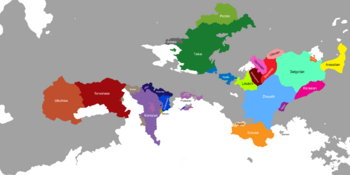 | |
Kento-Polyash languages are a Slavic language subgroup present in southern Thuadia, mostly in the areas of the Sekidean Union.

History
Kento-Polyash languages diverged from Germanic languages in the area of present-day southern Nerany in about 1st century BCE and slowly migrated to the equator in a span of 400 years, populating area from western Torvon across Kentalis, Krenya, Khemmi, Gadorien, Zhousheng, southern Bakyern, Monte Blanco and western Gabrielland. In about 6th century AD, Germanic tribes, mainly southern Bak tribes and Gadorieni tribes started pushing on Slavic settlements. Over time, most of the Slavic population, called the "Kartovians" in Gadorien was assimiliated into Gadori culture and language, only keeping old traditions in the remote area of Louzeni. Similar thing happened in Southern Bakyern, although there is still a area with a Ulevan majority. In the end of the first millenium, most of the areas formerly settled by Slavs in Torvon and in Gadorien has been assimilated into their new cultures (In the remote Duchy of Louzeni in Gadorien, Louzenish was created as a slavic language with strong germanic influences). Similar thing happened in Ereska, when new Khemmic settlers formed a lingustic corridor, splitting Kentalis from Ereska. Currently, Kento-Polyash languages are a majority in Mustelaria and Kentalis and a plurality in Krenya, while retaining minority status in Gabrielland and Gadorien.
Writing and alphabets
Former writing style of all Kento-Polyash languages was Protopolyash miniscule, which was retained until 18. century in most of the linguistic areas, but was eventually abandoned or edited in most of the countries (it is currently still used by Belgorian, Gorgavian and Karaalanish). Main problems with the script are lack of phonemes used in many languages, which makes one character represent multiple sounds and problems of drawing the letter, as some of them are complicated to be easily recognized from each other. Kentalis has reformed the script into a Kentalan alphabet, while Zhoushi/Bogmian language, Louzenish, Ereskaneese, Slovanic and Gabrielt Slavic adopted their versions of Latin alphabets.
Currently, a new project in Mustelaria is underway, trying to create an artificial mutually inteligible language named "Neo-Mustelarian" for easier communication among 4 slavic groups living in Mustelaria, this language has projected 30 phonemes and is written in Latin alphabet with diacritics:
| A a | B b | C c | Č č | D d | E e | F f | G g | Ǧ ǧ |
| H h | Ȟ ȟ | I i | J j | K k | L l | M m | N n | O o |
| P p | Q q | R r | S s | Š š | Ŝ ŝ | T t | U u | V v |
| W w | X x | Y y | Z z | Ž ž |
Language hybrids
Those languages are know for their hybridisation with neighboring language groups. Zhoushi language is a assimiliation of a Prei-Phnom language called Zhengian into a Slavic language called Bogmian. Similar phenomena can be seen in Louzenish, which is integration of Bogmian language with Gadorieni Germanic language, Gorgavian, which is a integration of Belgorian language with Gorgavinian language, which was a Language isolate[1].
Example of chosen Kento-Polyash languages (Lord's prayer)
| Common language | Zhoushi language | Belgorian language | Slovanic language | Karaalanish language | Kental language | Ereskaneese language | Velnotian language | Pecian language |
|---|---|---|---|---|---|---|---|---|
| Our Father in heaven, | Oþчe naш, kitory jesꞇєш na ƞieby, | ⲟⲧⲕⲓ ⲛⲁϣⲓ, ⲧⲓϣ ⲓⲥⲉϣ ⲛⲁ ⲛⲓⲉⲃϣⲓⲭⲁⲭ, | Otče náš, ktorý si na nebesiach, | ⲟⲧϣⲉ ⲛⲁϣ, ⲕⲟⲏⲧⲟ ⲥⲓ ⲛⲁ ⲛⲉⲃⲉⲥⲓⲙⲁ, | Оче наш, који си на небесима, | Otec naš na Nebesah, | Otče náš, jenž jsi na nebesích, | Отче наш небесный, |
| hallowed be your name. | mino Tiƿe buđ posviƌeno, | ⲡⲟⲥⲫⲁⲧⲓⲓ ⲥⲁ ⲙⲉⲛⲟ ⲧⲯⲟⲓⲟ, | posväť sa meno Tvoje, | ⲇⲁ ⲥⲉ ⲥvⲉⲧⲓ ⲓⲙⲉ ⲧvⲟⲓⲉ, | да се свети име Твоје, | pustʹ proslavitsja Tvoë imja, | posvěť se jméno Tvé, | да святится имя твое. |
| Your kingdom come. | Tiƿoje guo pꝛiȝađ, | ⲡⲣⲓⲓⲭⲟⲇⲓⲓ ⲕⲣⲁⲗⲫⲥⲧⲯⲟ ⲧⲯⲟⲓⲟ, | príď kráľovstvo Tvoje, | ⲇⲁ ⲇⲟⲏⲇⲉ ϭⲁⲣⲥⲧvⲟ ⲧvⲟⲓⲉ, | да дође царство Твоје, | pustʹ pridët Tvoë carstvo, | příjď králoství Tvé, | Ваше королевство пришло. |
| Your will be done, | biduч Tiƿuj janг, | ⲃⲓⲓ ⲯⲩⲟⲗⲁ ⲧⲯⲟⲓⲁ, | buď vôľa Tvoja, | ⲇⲁ ⲃⲩⲇⲉ vⲟⲗⲏⲁ ⲧvⲟⲏⲁ, | да буде воља твоја, | pustʹ volja Tvoja, | děj se vůle Tvá, | Ваша воля будет выполнена, |
| on earth as it is in heaven. | jak fu ƞeby, tak aj na zөmi. | ⲓⲁⲕ ⲯ ⲛⲓⲉⲃⲓ, ⲧⲁⲕ ⲁⲓ ⲛⲁ ⲍⲉⲙⲛⲓ. | ako v Nebi, tak i na Zemi. | ⲕⲁⲕⲧⲟ ⲛⲁ ⲛⲉⲃⲩ, ⲧⲁⲕⲁ ⲓ ⲛⲁ ⲍⲉⲙⲗʹⲓ. | и на земљи као на небу. | kak na Nebe i na Zemle. | jak v Nebi, tak i na Zemi | на земле, как на небе. |
| Give us this day our daily bread | Ȝilab maш tudejшij divaj mam dƞes | ⲭⲗⲓⲉⲃⲓⲕ ⲛⲁϣ ⲯⲍⲇⲉⲓϣⲁⲓ ⲇⲁⲓ ⲛⲁⲙ ⲇⲛⲓⲉⲥ | Chlieb náš daj nám dnes | ϩⲗⲓⲁⲃ ⲛⲁϣ ⲛⲁⲥⲩϣⲧϣⲛⲓⲏ ⲇⲁⲏ ⲅⲟ ⲛⲁⲙ ⲇⲛⲉⲥ | Хљеб наш насушни дај нам данас | Daj nam segodnja nasuŝnyj naš hleb | Chléb náš dej nám dnes | Дай нам на сей день хлеб наш насущный |
| and forgive us our debts, | aj ƿypujuшꞇaj mam гriȝy maшije, | ⲓ ⲟⲇⲡⲩϣⲧⲓ ⲛⲁⲙ ⲛⲁϣⲓⲉ ⲯⲓⲛⲓⲉ, | a odpusť nám naše viny, | ⲡⲣⲟⲥⲧⲓ ⲛⲓ ⲇⲩⲗⲅⲟvⲉ ⲛⲁϣⲓ, | и опрости нам дугове наше, | i prosti nam naši dolgi, | a odpusť nám naše hříchy | и прости нам долги, |
| as we also have forgiven our debtors. | jak aj my ƿypujuшamy mašim huoqum. | ⲓⲁⲕ ⲓ ⲙⲓ ⲟⲇⲡⲩϣⲧⲓⲁⲙⲉ ⲛⲁϣⲓⲙ ⲯⲓⲛⲓⲕⲁⲙ. | ako i my odpúšťame svojim vinníkom. | ⲕⲁⲕⲧⲟ ⲓ ⲛⲓⲉ ⲡⲣⲟϣⲧϣⲁⲯⲁⲙⲉ ⲛⲁ ⲛⲁšⲓ ⲇⲗⲩⲍϣⲛⲓϭⲓ. | као што и ми опраштамо дужницима својим. | kak i my proŝaem teh, kto nam dolžen. | jako i my odpouštíme svým hříšníkům. | как и мы простили своих должников. |
| And do not bring us into temptation, | Aj ƞevydaj mas fu pakuшenji, | ⲓ ⲛⲓⲉⲍⲯⲓⲉⲇⲁⲓ ⲛⲁⲥ ⲯ ⲡⲟⲕⲩϣⲓⲉⲛⲓⲉ, | A neuveď nás do pokušenia, | ⲛⲉ ⲛⲓ vⲩvⲉⲍϣⲇⲁⲏ v ⲓⲍⲕⲩϣⲉⲛⲓⲉ, | И не уведи нас у искушење, | Ne podvergaj nas ispytaniju, | A neuveď nás v pokušení, | И не введи нас в искушение, |
| but rescue us from the evil one. | le zibafuj mas ƿy Jingu. | ⲁⲗⲓⲉ ⲭⲣⲁⲛⲓⲓ ⲛⲁⲥ ⲟⲇ ⲍⲗⲟⲅⲟ. | ale zbav nás Zlého. | ⲛⲟ ⲓⲍⲃⲁvⲓ ⲛⲁⲥ ⲟⲧ ⲗⲩⲕⲁvⲁⲅⲟ. | но избави нас од злога. | no zaŝiti nas ot Zlodeja. | ale zbav nás od Zlého. | но спаси нас от лукавого. |
Flags of the nationalities
- ↑ Note: see Bulgarian language to imagine how this integration might have looked like
